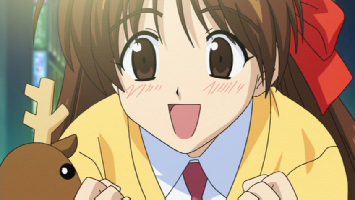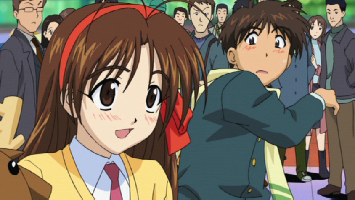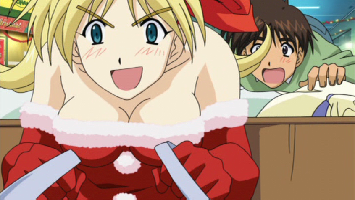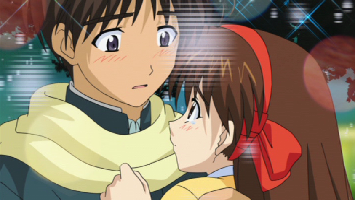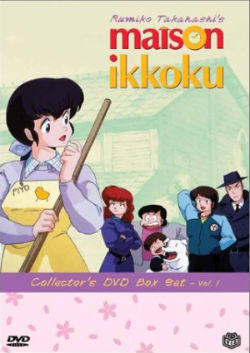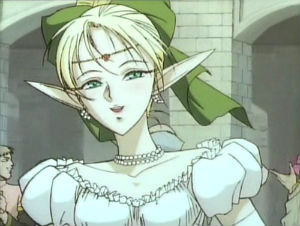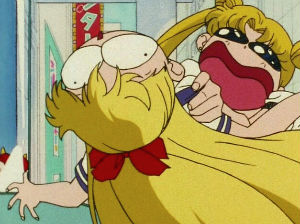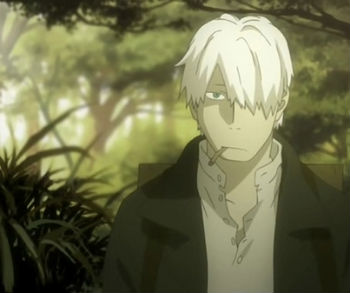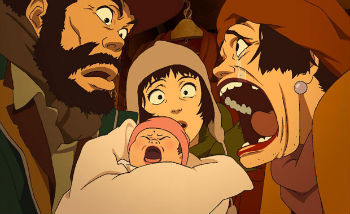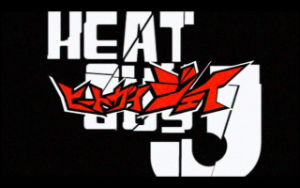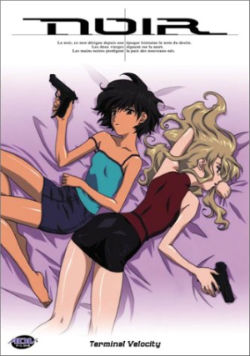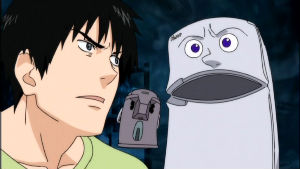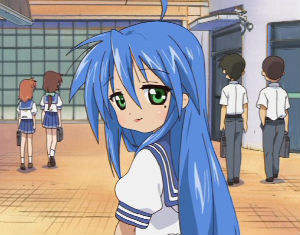

Quick Links:
The Anime Dream Ultimate Holiday Leg Warmer
I know what you're thinking: ultimate? Yes, my friends, we at Anime Dream intend to do what the large hadron collider has failed to do: unleash a world destroying torrent of year-end anime posts!
The posts begin with our buddy Mike, who offers a helpful guide of the one anime you should never watch, at Christmas-time or any time! (I wonder how many people know exactly what this title is without looking.)
After the familial and/or religious obligations are satisfied, the real fun begins. Every day from December 26 through December 31, we're going to present you with a list of top anime of the something-something. We're making this up as we go along, but it'll surely include the top anime of the decade in there, somewhere, so be sure to check back every twenty microseconds or so for the full scoop on what kinds of lists of anime you should probably never assemble!
(Waifu not required. There are other ways to keep the legs warm.)
Itsudatte My Santa! or What Was Ken Akamatsu Thinking?
Christmas is a huge holiday in Japan. However, the way they celebrate the holiday would seem alien to most westerners. Familiar icons like Santa Claus and festive trees are present, but so are somewhat unique traditions, like Christmas Cakes with Daiku (Beethoven's Ninth Symphony). Also unique to Japan is the idea of multiple Santas. The idea was toyed with before, in Ai Yori Aoshi's Miyuki feature. Love Hina creator Ken Akamatsu, however, decided that he wanted to offer his own idea of the holiday spirit. From that drive, Itsudatte My Santa! was created, and a new meaning to the term "crazy Japan" was born.
My Santa revolves around a lad named Santa. He was born on Christmas Eve, and his parents are the stereotypical absentee type. The whole "parents not caring" thing apparently led to a complex, as Santa is a dejected, Christmas-hating grinch. His life changes, however, when a cute brunette propositions him in a crowded square. After a moment of humiliation, the girl explains that she is Santa Claus. Well, a Santa Claus. For the sake of clarity, her real name is Mai, and she carries a plush reindeer named Pedro.
...Are you lost yet?
Anyway, the first episode revolves around Mai making Santa feel the Christmas spirit, in some form or another. The end result is that she becomes a full-fledged Santa who, in Akamatsu's mind, is apparently blonde, busty, and very cold. Aside from a few humorous sight gags (Mai can only make or do things that start with an S, like saugus, sample changing rooms, and san-setsu-bo (three-sectional staff)), the experience proves to be far more disturbing than heartwarming. Mai drags poor Santa through the first episode like an adorable Kool-Aid Man, uttering a creepy "Ho ho ho!" at every turn. The second half sees her practicing the wonderful art of breaking and entering, as she slithers down chimneys and delivers gifts.There seems to be little rhyme or reason to the show's progression, as characters appear out of nowhere, only to completely disappear moments later. Major plot points are badly placed, and leave little impact on the viewer as they're thrown out.
The second episode makes even less sense, as Mai is stranded with Santa, and therefore forced to spend a year in the human world. Mai's sister and rival appear to cause trouble, and predictable not-quite-hilarity ensues.
Commendations must be given to Aya Hirano (The Melancholy of Haruhi Suzumiya, Lucky Star) for her performance of Mai. She really gave life to the character's corny dialogue, especially the random "Ho ho ho"s that are randomly inserted in the script.The rest of the Japanese cast seemed less enthusiastic about the roles they were given. The English dub is absolutely atrocious, with stilted dialogue and a cast that simply doesn't emote. (Of course, given the material, I wouldn't either!)
While it's not the worst possible way to spend a lonely Christmas night, the same could be said about syphilis or a drunken stupor. My Santa is blatantly stupid, and shameless in its fan service. Those looking for a short dose of the Christmas spirit should stick to Charlie Brown or Rudolph. If one must mix some anime into the mix, I highly recommend Ai Yori Aoshi's Miyuki, or the Captain Tylor OVA White Christmas. Both are excellent features, and leagues above the dreck that is My Santa.
Five Anime You Probably Won't Find Now Even if You Want To
Everyone knows the publishing world is unpredictable, right? Yet, we all get burned once in a while with a product that slips off the map faster than we anticipated, only to show up on Ebay or Amazon at a high-enough price point to feed half of Africa. We're starting our holiday list-a-thon with a list of highly desirable anime which are out of print and, unfortunately, highly desired.
Maison Ikkoku: You'll never finish it.
The limited availability of this title has a simple, one-word explanation: Viz. The company is admirable for trying to push more shoujo and romance onto the market, but the market's not buying. Maison Ikkoku is a classic romantic comedy from manga legend Rumiko Takahashi. Unlike many rom-coms, the show offers a good amount of humor to balance the sappy stuff. The first box of 12 episodes is fairly easy to obtain, but you might want to check the price of the last few boxes before you get hooked. They were severely limited releases exclusively sold by Right Stuf. But hey, at least they released the whole series, unlike Full Moon.(Don't tell anyone who might steal the discs, but you can rent the show from Netflix!)
FLCL + DiGi Charat = What?
Nothing about FLCL makes any sense, so obviously everyone wants it. Problem is, the publisher (Synch Point, a defunct arm of Broccoli) is gone, and nobody else picked up the show. The good news is that you can get some of the soundtrack CDs in the states, still, but who knows where this hilarious little 6-episode OVA disappeared to. It's about ...I forgot.
Another Broccoli title that disappeared with the company's US operations is the Di Gi Charat TV series, nyo! It probably didn't make any money anyway, nyo! But tell that to the people trying to sell it, nyo! (I hope you're not one of the ones trying to find it, nyo.)
Record of Lodoss War and R.O.D. the TV: You might still have a chance!
Central Park Media is gone, but it's still possible to get yourself a piece of classic fantasy anime: the thirteen episode Record of Lodoss War OVA. It's a fantastic tale of swords and sorcery, but the important thing is: it has two elf chicks. It's a show you'll watch and think wow, it really is vital to have all those character classes! OK, so high fantasy isn't big on organic storytelling, but Lodoss does danger and distressed damsels and epic battle and victory of light against dark against all odds (except for that nagging detail of the witch Karla, who antagonizes both good and evil). The point is: you want this show, and if you act now, I'll throw in assurances that you might be able to get it if you try!When the US Arm of Geneon went down in flames, the inferno must have chewed up the Read or Die materials, because the TV series and its paper sisters appear to be orphans, and probably naked. (Their outfits are made of paper, you know.) As hot as this property was, it's hard to believe that it'll sit in license limbo for long; nonetheless, volumes of the show aren't too difficult to find yet! If you want the limited-edition box set of the series, that's another story. This tale — of strange and wondrous abilities with paper, and of an author's not-so-quiet fight against the tyranny of long dead men trying to grow green tentacles — is worth experiencing, though, so get on it.
Links:
Four Anime Buried Under Fenway Park
Sailor Moon:
If there's one thing to be said about Sailor Moon fans, it's that they are unquestionably devoted to their favorite series. Most are also batshit loco, but that's another story for another day. Sailor Moon is currently one of the most sought-after DVD series on the market, despite parts of the show receiving a decently wide circulation.
Sailor Moon originally aired on American (and Canadian) TV in a heavily edited format, courtesy of Dic. After the seeds of the initial run were sown, the legion began to amass slowly but surely. Pioneer Animation introduced fans to the darker, sometimes racier side of the series in 2001, when they released the first uncut volume of Sailor Moon S. Suddenly, Neptune and Uranus weren't Alabama-style "cousins" anymore, and characters weren't simply "banished to the Negaverse." Instead, the senshi were finally identified as lovers, and characters actually freakin' died. Both Sailor Moon S and SuperS were released to much fanfare, and saw outstanding sales over a number of releases.The original series wasn't as fortunate, though. ADV Films previously released the dubbed DVDs for the original Sailor Moon in the US. However, the uncut series seemed to be a no-go, as Toei was unwilling to negotiate, and American companies didn't have pockets deep enough to pay the licensing fees. A miracle for the fans came about in 2002, however, when ADV's Dave Williams announced that the company snagged the rights to both Sailor Moon and Sailor Moon R in their uncut, unedited form. At this point, the internet became a critical mass - fans were squealing, non-fans were groaning, and everyone else just wanted both sides to shut the hell up.
The first set contained all 46 episodes of the original Sailor Moon, and was released in 2003. The set was heavily flawed, though. Instead of the new masters used in Japan's (at the time) recent re-release of the show, Toei shoved old, decayed masters into the hands of ADV. Grainy, dirty film coupled with distored mono audio that made old fansub tapes seem superior in quality. However, the set still sold, and sold well.
In 2004, Geneon and ADV both revealed that Toei was not renewing the licenses for any Sailor Moon product, and that all DVD properties would lapse by 2005. This triggered a buying frenzy among fans, collectors, and eBay sharks, who snapped up the show quickly. Within weeks of the license lapse, Sailor Moon was simply unavailable, despite demand.
Sailor Moon fetches a princely sum on eBay, Amazon, or other outlets due to the rarity. ADV's sets for the original series often hit upwards of $200, often settling between $250 and $600 per set. Geneon's sets, due to numerous rereleases, often fetch far lower values. Singles of S and SuperS can be found at prices that range from $18 to $25. However, complete sets of the shows often run between $200 and $300.
City Hunter:
City Hunter is the perfect example of a show that was doomed from the start. Before its US release, ADV solicited fans for pledges to purchase the series. By "pledge," I don't mean signing a document that says "I promise I'll buy this! I really really do, sir!" ADV required a preorder - credit card information was collected, and billed as soon as the DVDs shipped. The preorder prices for each volume began at $124.98, and would drop with preorder volume - an absolute minimum for each set was 2,000 units.
The first two seasons of the show performed strongly, and a decently large number of sets were released to retail with a suggested price of $89.98. City Hunter 3 and 91, however, are an entirely different story. Both City Hunter 3 and 91, due to a number of unknown factors, were shipped in exponentially lower quantities than the first two seasons. The collectors snapped them up quickly, and the shows weren't restocked. The licenses for all City Hunter shows lapsed ages ago, which means that whatever hit the market was all that fans could get.City Hunter is a series that varies in rarity. The first season and all of the movies are incredibly easy to obtain. City Hunter 1 typically fetches $13 to $30 per 5-disc set, while the films can be had for $2 to $4 each. City Hunter 2 is a bit less common, with prices ranging from $20 to $50 per set. The fun begins with City Hunter 3 and '91. City Hunter 3 is the less rare of the two, and often fetches from $120 to $200. City Hunter '91 is the most difficult to find of the series - it wouldn't be uncommon to pay $200 to $500 for this 3-disc, 13-episode set.
Cardcaptor Sakura:
This series has three factors that ensure its collectability: It's a CLAMP show, it had a stellar cast, and it was freakin' long. Cardcaptor Sakura spanned 70 episodes, which were released across 18 volumes in America. Pioneer Animation released the series from 2000 to 2003 and, at the beginning the series fared well in the marketplace. Chad Kime, former Pioneer Marketing Director revealed that the show's performance was halved after the company was pressured to release volumes 4 and 5 out of order. The show still sold fairly well after that point, but nowhere near what the company hoped.
Cardcaptor Sakura is somewhat rare, but earlier volumes are still obtainable. Single volumes vary in price, from $9 to $150, with later volumes fetching progressively higher prices.
Gunsmith Cats:
Gunsmith Cats is a series that should have had more appeal in America than it did. It was a straight-forward, no-nonsense cop flick, spread across three OVAs. From all indicators, the show performed decently - at least enough to warrant a remastered DVD edition. Licensing issues arose however, and the title became very sparse on the market very quickly. David Williams explained to me that, while the DVD sold decently, ADV was simply unable to renew the license with the Japanese copyright holders.
Gunsmith Cats is fairly rare in the market today, with new copies ranging from $60 to $300. Used copies fluctuate in value between $40 and $60.
Personally, I spent close to two years hunting down a copy of the Gunsmith Cats DVD. Having snatched up the omnibus manga volumes and a copy of Riding Bean, I just had to get one more fix of Minnie May and Rally's exploits. However, price is the ultimate equalizer. There is simply no way I could rationalize spending the price given on one OVA. My fortunes turned at this year's Anime Boston, however, when I found a copy of the feature for sale at Dave Williams's booth for $60. At the time, I only had $50 to spend. I threw out an offer and, thankfully, Mr. Williams accepted it. Once again, I want to say "Thank you!" to Section23's David Williams, for giving me that one last fix.
Links:
Eight Quality 2000s Anime You Might Have Missed
Inspired by a similar post at Reverse Thieves, I present to you my list of anime that you might have missed during this fine decade, and if so, consider this a holy mandate of thou shalt watch them.
Haibane Renmei (2002) & Niea_7 (2000)
Haibane Renmei got a little attention on the fansub scene, thanks to Yoshitoshi Abe being that guy who did the character designs for Lain. The title collected dust for a while, then finally was released by Geneon in 2005, and by then, not too many people were talking about it. With a setting inspired by Hard Boiled Wonderland and the End of the World, a Haruki Murakami novel, Haibane Renmei is a story of discovery and emotional/spiritual growth centered around the angel-like haibane, who are "born" into this world with no knowledge of where they came from or how they got there. We learn with the newcomer, Rakka, how this new world works, and the circumstances under which a haibane is able to leave. Very highly recommended.
Yoshitoshi Abe also made a wacky little show in between Lain and Haibane, called Niea_7 (pronounced "nee-uh under seven"). The show made few waves, if any at all, and that's a shame. Like Haibane, it's a spiritual title, centering this time on the Buddhist core tenet of "everything changes," or as we know it, "shit happens." Niea is an alien, but she doesn't have an antenna like the other, higher-class aliens, so her peers label her as an "under 7," the lowest possible class. You wouldn't know it, though, because Niea's incurable optimism and sense of humor regularly overwhelm her roommate, Mayuko. A diametric opposite, Mayuko is a quiet and depressed cram school student. In addition to being about their daily lives, Niea_7 explores themes of racial stereotyping and integration, sentiment as a crippling force, and change as relief. Don't let its weirdness scare you away; it's definitely worth it.
Kino's Journey (2003)
Kino no Tabi: The Beautiful World didn't get a lot of buzz while airing, so far as I can recall. The ADV release in 2004 generated a good number of recommendations, though, especially on the Anime on DVD forums. Anyone asking for a slice of life recommendation is still bound to hear "Kino's Journey" in response, but as it's fairly difficult to explain the appeal of this show, I suspect that plenty of fans haven't managed to see it yet. This is a grave mistake, and not just because they're missing an amazing theme song (All the Way, by Mikuni Shimokawa).
Kino is a young girl who travels the world on her talking motorcycle, and periodically learns about a new country. She never stays in one place longer than three days, as in her words, it's enough time to figure them out — their problems, strengths, and quirks are readily visible to an outsider. The countries all symbolize a specific social ill or advantage that you might find in a more-complex society, i.e. modern countries are each some combination of these. Kino occasionally is tempted to stay longer, or decides right off the bat that sticking around isn't a great idea, and all of her visits reveal a sliver of her character to the audience. It's a neat show, so watch it!
Mushi-Shi (2005)
Mushi-Shi took me by surprise. I picked it up after an anime burn-out period; while looking for a recommendation for macabre or moral anime, someone threw it my way. I had actually never heard of it at that point, and I get the impression that few people talk about it.By the standard interpretation, mushi means "bug." The show's mushi aren't necessarily more important than insects are to the world, but they are more of a paranormal phenomenon — anything from simple life forms that interact with humanity by chance, to the very fabric of nature. Ginko is a man who can perceive and study these bugs. His occupation as mushi master (mushi-shi) is to help people who experience ill effects from interaction with the mushi. Much like Kino's Journey, Mushi-Shi's objective is to assemble a view of the natural world through Ginko's experiences, and to progressively learn about the man himself. Ginko is somewhat a tragic character, being that his tendency to attract mushi forces him to forego a long stay at any one place, but one gets the sense that he finds at least some aspects of his life fulfilling. Everything about this show is presented in a way that feels interesting and new, and it's difficult to not get drawn into the characters' lives.
Kaze no Yojimbo (2001)
This is an odd show, in the sense that it bears the name of Kurosawa's classic comedy in its title, but it's not a comedy. The show is a murder mystery which happens to borrow character personalities and style elements from its spiritual predecessor, Yojimbo. It had the looks of a dirt cheap production, and I suspect that critics are the only people who saw this show in the states.
George Kodama (not his real name, naturally) travels to the bohunk town of Kimujuku looking for clues explaining what happened to his brother, a soldier who boarded a train years prior and never returned. He's a pretty talented fighter, so he's able to work as a bodyguard (i.e. youjinbou) for the two competing gangs in town, while simultaneously stirring things up a bit between them. George acts out of his obsession to find the truth, and while he doesn't expressly invite chaos, innocent people get hurt. Kaze no Yojimbo is about confessing the sins of the past and putting a community back in balance. Its cheap look might be a turn-off for some, but I found the title as a whole engaging.
Boys Be... (2000)
This show went unlicensed for what seemed like an eternity. A few of us (me included) looked to a release from Singapore (published by Odex) in order to check it out. The Odex release was a bit sloppy on the English front, but the subtitles were leagues above bootleg quality, at least. Nevertheless, it was good news when Nozomi / Right Stuf picked up the license.
Boys Be... is a story of teenage romances from the male perspective. It follows Kyoichi the artist, Makoto the nerd, and Yoshihiko the jock, through their misadventures at dealing with the female element. Aside from Kyoichi channeling Shinji Ikari a couple times, the relationships presented are refreshingly normal and harmless (to the audience). That's not to say the characters don't have their share of trials, jealousy, and soul searching, but all of humanity doesn't get sucked inside a big amoebic blob of former humans. Did I mention the soundtrack's really good?
Tokyo Godfathers (2003)
If the words "Satoshi Kon" aren't enough reason for you to see this movie, there might not be much I can do for you. Still, if there is a Satoshi Kon movie that people might have skipped by accident, it's this one, and it's as worthy of a viewing as any of the others.
Partly adapted from an old movie, 3 Godfathers, the film shows us three homeless people: a tranny, teenaged girl, and a former salaryman, as they find a newborn child in a garbage heap. It's a tale of redemption, in which we see the baby bring each of the fallen in contact with their former lives, often in hilarious and unpredictable ways. It's a feel-good film for anybody who's ever felt lost or trapped in a life they didn't deserve.The Girl Who Leapt Through Time
Now, this title is pretty well known, as anything with Yoshiyuki Sadamoto character designs is bound to draw some eyes; however, it has come to my attention that there are people out there who have not seen this movie. This is, frankly, unacceptable.
Adapted from the novel of the same name, Toki wo Kakeru Shoujo (shorthand: tokikake) is a visual feast and a fascinating story about how time operates on human lives. It's the story of Makoto, a teenaged girl who makes a bad day both better and worse by discovering a device that lets her jump (literally) back in time. It's a story that, like several before it, aims to deflate the romantic sentiment of "if I had it to do all over again...," while throwing some big picture ideas like the rise and fall of civilizations into the mix. Add to that a blend of gorgeous still-life photography and animated Van Gogh, and you have one of the finest films to come out of Japan yet.
So what are you waiting for?
Links:
The Top 5 Industry Disasters of The Decade [Updated]
Updates/Corrections:
Correction: Section23 Films
Griffin D. Vance was ADV Films's Senior Vice President of Business & Legal Affairs. He was not one of the company's co-founders, which consisted of John Ledford and Matt Greenfield.
While it's fun to list our favorites or the rarest shows of the decade, it's best to put the decade into perspective. The anime industry is vastly different than the bustling cottage industry of the '80s, or the booming tour de force of the '90s. The '00s instead will be remembered for the implosions, the disasters, and the misfortunes that befell the industry. Before we say goodbye to the decade, it might be best to look at the biggest industry crises that hit in the past ten years.
1) ADV Films: Died, September 21, 2009
It's impossible to talk about industry disasters without mentioning the most war-torn company to rock the industry. At the beginning of the decade, ADV was in an enviable position. With a large cash reserve, tons of highly desired titles, and a giant amount of fandom goodwill, ADV was one of the mainstays of the anime industry. They made a huge showing at every major convention, from Anime Expo to Otakon, as well as a number of smaller cons such as (at the time) Anime Boston. Few seemed to question ADV's massive growth, and its even bigger number of acquisitions year over year. Be it Keroro, RaXephon, or Azumanga Daioh — if one were to guess the company holding a show, there was a good chance it was ADV.
The good times were quickly coming to an end, come late 2005. Years of fierce bidding wars and foolish acquisitions (Petit Princess Yucie? Really? I love Princess Maker as much as the next guy, but still...) depleted the company's coffers, and output began to decrease drastically. The company's luck seemed to change drastically on June 27, 2006 when they announced that they would partner with Japanese investment firm Sojitz. Through the partnership, ADV would receive an unspecified sum of money in exchange for acquisitions of American content on the company's behalf.
What's a company flush with cash after a crisis to do? Any logical mind would say "invest wisely, and don't extend further than you have to." ADV, on the other hand? They went shopping. The company fell into the same bad habits they had in the early 2000s. For the most part, things seemed great on the outside. In 2007, acquistions were increasing, titles were being released faster than ever, and ADV was even lining up a distribution deal with then-ailing Geneon Entertainment, which they announced in August. At the same time, though, the number of re-releases seemed to be growing by the month.
Karma finally came around in September of that year, when misfortune after misfortune began to hit ADV like a sack of bricks. The first blow was the dissolution of the distribution deal with Geneon. ADV announced that they would assume distribution of all Geneon properties by October 1. The deal fell apart in due diligence, however, which led Dentsu to issue a press release stating the opposite. Dentsu stated that the companies were "unable to reach a mutual agreement" on the matter.
In January 2008, a large number of titles acquired with Sojitz's funding were removed from ADV's website, including the high-profile Gurren Lagann. ADV was treating Gurren Lagann as a major release, and had already mailed test discs out to members of the press, as well as retailers. ADV never gave an answer on what happened to the title until May 2008, when Bandai Entertainment revealed its acquisition of the license. Things grew worse that July, when Sojitz took their ball and went home. They reclaimed roughly 30 of the titles they acquired with ADV Films, and sold the rights to FUNimation in July.
After Sojitz backed out, ADV became a much less vocal member of the community, and began to focus on re-releases, and distribution for the mysterious companies Sentai Filmworks and Switchblade Pictures. Both companies were later discovered to be fully owned by ADV co-founder Griffin D. Vance. As of May 2009, ADV was still claiming to be absolutely fine. At their Anime Boston panel, David Williams continually reassured fans that ADV was not going anywhere. This didn't last long, though. On September 1, ADV Films revealed that they were shuffling all of their assets around. Everything from The Anime Network to the titles to distribution rights were sold to four companies: AEsir Holdings LLC, Seraphim Studios, SXION 23 LLC (Section23), and Valkyrie Media Partners LLC.
Section23 became the de-facto "New ADV", as ADV Films essentially sold itself to itself. The company was split to take advantage of a number of legal loopholes. The company runs now, same as it ever did. However, the ADV monolith most of us came to know and love is now gone forever.
2) Geneon Entertainment: Died, September 28, 2007
Geneon is the other textbook case of Murphy's Law in action. Originally Pioneer Animation, Geneon saw a lot of early success with titles like Tenchi, Trigun, and Pokémon. The company was seeing 20% year-over-year growth, which created a speculative bubble. In the bubble, fierce bidding wars made properties increasingly expensive. However, Pioneer seemed invincible due to the success of the Pokémon license, which was drawing in over a million sales per month.
The landscape began to change in 2004, when the anime bubble was at its biggest. Former Geneon Marketing Director Chad Kime (via Anime News Network) revealed that there was a flip in profitability, combined with a massive delay in the ability to see the writing on the wall. The bidding wars escalated to the point where companies were bidding on titles that weren't even in production. All of the major players were putting money down on titles to secure day-one licenses. According to Kime, nobody in the industry realized that the bubble was bursting because so much was coming through the pipeline, all of which was being absorbed by Best Buy, Musicland, and the like. Before long, the product began to come back.
The company's fortunes worsened in 2005, when they were acquired by Japanese advertising agency Dentsu. Pioneer became Geneon in the eyes of the public. Internally, though, it was an entirely different story. According to Chad Kime, the company was saddled with debt from the date of purchase. Through the terms of the agreement, Geneon had to relinquish its entire war chest to Pioneer Electronics. All of the money that Pioneer Entertainment amassed through the '90s suddenly became a mountain of debt to Dentsu, plus interest. A few months after the acquisition, nearly a quarter of Geneon's sales from the previous quarter were returned. The end result was a liquidity crisis in the corporation.
Few of Geneon's titles going forward broke even. Some shows, such as Cybuster and Rumiko Takahashi Anthology, required 10,000 units to break even. They sold less than 100 units.
Through the bubble, Geneon pushed through far more product than they can handle, in order to stay on par with the budgets set by Dentsu. In order to keep up with budgets, Geneon had to pay too much for titles, which forced them to ship more copies, which led to more returns, which led to Geneon needing to release more titles despite a glut, and so on.
The company gasped its last breath on Sepember 26, 2007. Geneon issued a release to retailers stating that they would not issue new product. All business operations would cease for the company that Friday, September 28. Only orders for back-catalog titles or titles with street dates before November 6 would be honored. Returns would not be honored past November 30, 2007.
Geneon still technically "exists" at the moment, but they will not license new titles. They are a holding company that will only exist until their licenses expire.
3) Dispute Between Central Park Media and Libre Publishing
In March 2007, Libre Publishing started dirtying the business pools with one of its biggest American partners. The company posted the following notice on its website:
Thank you very much for your continued interest in our publications. Please note that we also offer copyright licensing service for translations of our own publications to foreign publishers. These are commissioned by each of the cartoonists and authors.Recently, it has come to our attention that some translations of our publications have been published and some are to be published by Central Park Media (Label: Be Beautiful) in the United States. We wish to make it known that these publications are considered illegal because they have not been authorized by us. It should also be known that the cartoonists and authors are being victimized by this illegal act, and they are very annoyed by it.
We strongly protest this illegal infringement of our property and issuing a strong order for CPM to cease their illegal acts. We also wish our faithful readers to refrain from purchasing, loaning, or sharing any and all of these illegal publications. Thank you.
Libre Publishing Co.,Ltd.
Further digging by numerous outlets revealed that the notice was posted in the wake of publisher Biblos's bankruptcy. Central Park licensed a number of boys-love titles for its Be Beautiful line from Biblos Publishing. Libre alleged that Central Park never renegotiated the licenses when Biblos folded, and the titles reverted to Libre's ownership. Shortly after the news hit, CPM managing director John O'Donnell revealed that Libre never filed a lawsuit against Central Park. Furthermore, Libre refused to discuss the issue or negotiate with Central Park Media. O'Donnell alleged that CPM's licenses were still legally binding, and that the company was trying to harm Central Park's reputation and sales until the licenses expired.
The issue became moot on April 27, 2009, when Central Park Media filed for Chapter 7 bankruptcy.
4) Musicland Meltdown
On January 12, 2006, Musicland announced that they would file for Chapter 11 bankruptcy protection. Musicland was the owner of a number of retail chains, including Sam Goody and Suncoast. All of them were large retail suppliers for anime. When Musicland filed bankruptcy, they triggered the closing of 284 retail locations. In addition, the company's massive debts were effectively erased, which left companies like FUNimation and ADV Films in the cold. In particular, FUNimation was owed $12.8 million from Musicland, and the fallout was enough to leave Central Park Media particularly vulnerable in the marketplace.
5) Heat Guy J
Chad Kime revealed in a recent ANNCast that Heat Guy J is a title that still makes him cringe. The series was a potential "perfect storm," with an excellent pedigree and a high-profile studio doing the animation. Heat Guy J was the brainchild of Escaflowne director Kazuki Akane, and utilized a large number of staff from the Escaflowne team. Pioneer, at the time, figured that the show would be a gem. The deal was sweetened by the fact that the entire industry was seeing 20% year over year in profitability, and the show was not due for two years. Pioneer bid a high sum of money for the show, which they never saw in return due to the vastly different landscape the show faced when it finally hit. The series saw massive advertisement, but still struggled to perform. Final sales tallies saw Heat Guy J thoroughly bomb, selling less than Ai Yori Aoshi.
Links:
Four Crimes Against Humanity (2000s Edition)
This time, I present a list of four things which, in my mind, brought down the collective quality of the anime industry in the last decade. You could say it's kind of a personal pet-peeve list, although I like to think I'm not alone on the points below.
Bee Train
Not every title from Bee Train is worthy of "crime against humanity" status, but I can't think of another studio that so regularly disappoints me than this one — the primary reason being: they're great at animation and terrible at storytelling.
Noir, one of their first major productions, is a perfect example of this. In between its seriously impressive action scenes, the show treats us to a Léon the Professional inspired home life, with Mireille the assassin taking Kirika the amnesiac under her wing. This is where the trouble starts. An amnesiac main character is an absurdly lazy plot device that clues the viewer in to an unsurprising oedipal twist to come, but some directors manage to make the journey interesting, by keeping us as close to the protagonist's mindset as possible (see: Memento). The problem with Noir is: its use of the puppet master device interferes with the oedipal fall by shuffling ultimate responsibility off onto a clear villain, and the show turns into a standard shoot 'em up marathon to the final boss. It's a total buzz kill.
On the other hand, Noir manages at least to get the viewer buzzed. Avenger, by contrast, is the worst excuse for a revenge story that I have ever witnessed. Quoting myself, "the creative team at Bee Train managed, somehow, to craft a vengeful main character that I couldn't possibly care about, in a setting that could scarcely be less interesting." I mean, if following an emotionally comatose girl and her weird android-like sidekick around a Mars wasteland where no children are born (in an obvious invocation of the Japan birthrate "crisis") is your bag, then more power to you, but I couldn't get into it.
I sampled a volume of Madlax at one point, and clued in to the similarities with Noir pretty quickly. And I don't even have to sample El Cazador de la Bruja in order to rightfully suspect the same. I will eventually give both series the benefit of the doubt, but the point is: a viewer familiar with Bee Train's major works has little reason to suspect better with each new offering. I'll admit that it was Avenger that ultimately soured my view of Bee Train, and it is only one title; however, subtle but fundamental issues plague many of the other titles.
I will say that the .hack titles are rather good by comparison (they aren't a Bee Train title per se, but the studio was involved heavily), and they make it difficult to write off the studio as a bad choice for a viewing experience. And to my complete surprise, I enjoyed the hell out of Murder Princess, because it was bad in that entertaining, unapologetic way. It still saddens me that I feel this way about Kouichi Mashimo's studio — I mean, it's Mashimo, the man who brought us The Irresponsible Captain Tylor and Eat-Man!
Geneshaft (2001)
Geneshaft is one of a handful of titles that I simply could not bear to watch. It's that bad. So, being the boss, I handed it off to Mike for review, and I do regret that a little, because I know that he will never forgive me.
Apparently in the future, humanity decides that the ideal makeup of society is to have these space harems where women outnumber men nine to one, and the women even get a ranking as to how pedigreed their genes are! As if that isn't enough, society decided that people over forty-five years of age are worthless (presumably because women enter menopause at or shortly after that age, but of course they cover it up by claiming that it's the age where health and performance degrade in humans). To top it off, the action in the series features the girls piloting the phallic giant robot, "the shaft," to destroy the ring-like weapons that appear out of nowhere and blow things up.
Origin: Spirits of the Past (2006)
At this point I'm getting a bit rant happy, but let me just say: Gonzo bugs the hell out of me. They have so much talent at that studio, and yet it's incredibly rare that they'll produce a title where everything comes together well. Last Exile is one of these rarities, and to be honest, I rather enjoyed Vandread. But I digress.Origin is Gonzo's stab at eco-politics, but make no mistake: it is no Nausicaä, and it is no Princess Mononoke. Set in a dystopian future where plant experiments on the moon run wild and take over the world, it's all about being touchy-feely with the trees and atoning for how we humans had the gall all those years to try and make better lives for ourselves using technology. Didn't we know that human intelligence is a disease that must be eradicated?
At any rate, the trees become sentient and decide that humans are unworthy to manage the world, so they ration the humans' water supply. Of course, being human, our protagonist and his friend try to steal some water, only to discover a girl in a cryogenic sleep pod and wake her up. Because she's from the old world and thus has knowledge of it, the trees see her as a threat and try to force the humans to give her up. Then a human from a warmongering "take no shit from trees" club swoops in and takes her, and our hero gets a power-up from the trees (a sort of mystic fusion which eventually turns the human into a tree) and runs off to save her. Predictable epic struggle for a coexistence with nature ensues.
The weird thing about Origin isn't that it's bad — plenty of titles are. But this title never seemed particularly salable to me, yet it scored a blu-ray release in the States, which blew my mind.
Ichi the Killer: Episode Zero (2002)
I'll admit I'm not the most adventurous of anime fans, but I like a title from time to time that challenges my worldview or shows me something of the dark underbelly of humanity that I've never been exposed to firsthand. But the animated Ichi the Killer is gratuitous garbage with no real point to it, at least that I could tell. Cliff Notes version: the episode is about Ichi discovering that he gets off on physically hurting people, i.e. he's a sadist nutcase. The episode aims to show, in graphic, disgusting detail, just how screwed up this guy is, and pretty much everyone he comes in contact with. I'd stay away from this title unless you're looking into it for research, in which case I feel sorry for you.
Links:
The Top 5 Otaku Pander Anime of the Decade
The Law of Conservation of Creepy states that everyone who's into anime knows at least one otaku. I'm not talking about the American "Hey, I like anime — I'm an otaku!" type. I'm talking about the full-on, jobless, never bathing, lives in his mom's basement otaku. The level of otaku that will bring shame upon the household. These people tend to be fairly miserable, or pretend to be happy. Japan realizes that this type of fan exists, and therefore makes shows to capitalize on these pathetic souls. These shows can be enjoyed by just about anybody; however, there is a special something, a certain quality that otaku can latch onto, and somehow feel better about themselves. What qualities do I speak of? Well, some offer comfort, others offer, er... "other" feelings that I am not comfortable mentioning.
5) Azumanga Daioh!: Premiere — April 8, 2002
On the surface, Azumanga is a fairly cute, funny slice of life show. The concept is as simple as can be: a bunch of girls attend a high school where the teachers border on psychotic. Classes are attended, Murphy's Law kicks in, and hilarity ensues. There are enough sight gags and jokes to entertain almost any fan.Beneath the cutesy exterior, though, Azumanga latches on to the lonely otaku. Each of the main characters is a representation of the popular archetypes: Chiyo is the token loli, Sakaki is the gorgeous yet shy one, Osaka's the spacey one, and so on. The show provides an outlet for almost any schoolgirl fetish one can think of. In that light, one could see the slack jawed Kimura-sensei as an analogue for the viewer, as he is open about his lust for the girls, going as far as to take up a teaching gig so he can ogle them.
4) Welcome to the NHK!: Premiere — July 9, 2006
Welcome to the NHK could be taken as almost ironic in its treatment of the otaku. The series is beyond brutal in its protrayal of otaku, hikkikomori[1] rather.Tatsuhiro Sato, the main character, is portrayed as a quiet, paranoid individual that suffers from an extreme case of agorophobia. He hates going outside, and fears talking to people in general. He sleeps 16 hours a day, and spends the other 8 whacking off or slowly descending into madness with constant conspiracy theories that his socially-ill mind cooks up. In particular, he thinks that TV network NHK is trying to mass-produce anime otaku by producing anime, which would create a society of unemployed fatties. The "Nihon Hikkikomori Kyokai", in the words of the show.
How does this pander? Simple. Sato's resolve begins to change upon meeting Misaki Nakahara. She claims to be able to cure his hikkikomori ways. The series plays to an otaku's desire to be rescued, to be loved... preferably by a cute girl. The show also touches nerves on addictive personalities, such as when Sato joins an MMO, as well as the otaku's seemingly endless love of porn. The series proves to be beyond dark in its delivery, but there's a strange, almost comforting aspect that is woven into the narrative. The overt sexuality doesn't hurt, either.
[1] A hikkikomori is a shut in — somebody who confines himself to his home, effectively withdrawing from society, due to various social or personal issues.
3) Lucky Star: Premiere — April 8, 2007
Lucky Star is an absolute treat for otaku. The character of Konata alone ensures that there will always be some focus on games, anime, or the like. Jokes about obscure anime like Marimite, and the popular titles like Keroro, Initial D, or Haruhi will have the trivia nerds tickled pink. The Comiket portions should hit a few nerves with anybody who braves the dealers room at large anime cons like Otakon or AX enough to have a frequent-buyer card.The content of the show itself proves to be fairly mundane mostly, as characters talk about things like how to eat a chocolate cornet, or how to make the perfect curry. It's hard to say just what panders to the otaku in such limited space, but it may be that sense of normalcy, the familiarity and acceptance an otaku truly craves. Nobody treats Konata as the outcast, even though she's clearly the black sheep — the anime nerd, the hardcore RPGer and erogamer. Most otaku really can't claim to have friends like that.
In addition, there is a large amount of moé fan service, and tons of allusions to said service, that drives otaku wild in another way. Cosplay, bathing suits, kimono... it's all fair game.
2) Genshiken: Premiere — October 10, 2004
I've said it before, and I'll say it again. Genshiken is one of the best examples of an otaku's mindset. The series is merciless in its description of every huge otaku subculture, from gamers, to anime geeks, to manga fiends and cosplay fanatics. All of them are proud of their obsession, and revel in their discussions over which episode of Kujibiki Unbalance was better, or if Guilty Gear Isuka really is the paragon of all fighting games.
The series constantly justifies the typical otaku behavior, and rationalizes the more questionable segments of the culture, such as rape games, panty fetishes, and irrational character attachment. The rationalizations are tied together with a strong comeraderie between the characters, which hints strongly that, no matter how outcast a person is, there will always be others like them. Be it on the 2ch message boards, or in the depths of Toranoana, there will always be a person out there who is just as bad as, or worse than you.
The major females, while strong characters in their own right, serve the obvious fan service position, with revealing cosplay shots that will fuel doujinshi for many years to come.
1) The Melancholy of Haruhi Suzumiya: Premiere — April 2, 2006
Where to begin?
Haruhi is the birthplace of countless internet memes, from the Mikuru Beam, to nyoro~n and then some. Hare Hare Yukai has become the anthem of the raging otaku, as well as the screeching fangirl, and God Knows is a perfect candidate for "Otaking's preferred music," as it was both incredibly popular (peaked at #5 on Oricon's top sales charts), and it received prominent placement in the anime.Haruhi fits the perfect otaku mindset — disinterested in anything that doesn't fit her narrow definition of "amazing," and brutally rude to anyone around her. Those she finds are around only to suit her needs, and are therefore are disposable in the long run. And, if something bores her? The consequences are simply dire.
Mikuru is the [wet] dream girl of the otaku. She's has a cute face and a great body, and she's submissive to the point of not knowing that she can say "no." As a result, Haruhi dresses the poor girl in every fetish outfit imaginable, from bunny girl to maid, to sexy maid, to... well, you get the picture. She's eye candy that gets molested, fondled, and groped by the aggressive Haruhi at every turn.
Haruhi managed to ingrain itself into otaku culture in a way that's rarely been matched. It pandered to many of the popular interests and fetishes, on top of being a top-notch title that stands well on its own. Such a feat is something to be admired, respected even. For that, Haruhi gets the dubious honor of top otaku pander show of the decade.
Links:
Staff Rankings: The Top Anime of the Decade
Anyone who's been reading us for a while knows that we're not big on lists. It's the end of a decade of anime, though, and we figured it was time to get some lists out of our system, and then go back to what we do best. Being the last day before the year 2010, it's time to unveil our picks of the decade, but not as one "official" list.
Linked below, you'll find the picks for each staff member who wished to participate. (Or if you came in from the main Spotlight link, they'll appear right below this post!
Links:
Staff Rankings: Viarca's Top 5 Anime of the Decade
5) Naruto ‽ (2002)
Part of me objects to including this title in my top 5 list, but I think it’s important and only fair to acknowledge Naruto for being the Dragon Ball Z of this decade, and serving as a gateway to indoctrinating a new generation of anime viewers. While many veterans of anime regard it with disdain, anything that might get fans curious about what else anime has to offer — and there is no arguing the show has received more attention in the US than any other this decade — deserves to be included in my list.
4) Fruits Basket (2001)
Fruits Basket makes my list as much for its manga as it does for the comedic value and shoujo theme of the anime. The story of an endearingly hapless young girl taken in by a family full of pretty boys with a very strange curse, the anime delivers lots of laughs and memorable characters.
3) Code Geass: Lelouch of the Rebellion (2006)
For the third ranking, I’m compelled to go with something a little more mainstream in Code Geass/ Code Geass R2. Full of morally-grey characters, a plot that has twists at every turn, giant robots, and character designs done by CLAMP, the show has something that appeals to most anime fans, and certainly didn’t disappoint me.
2) Makoto Shinkai (2002, 2004, 2007)
While this technically should not be a single mention, leaving Makoto Shinkai off the list despite his vision in creating Voices of a Distant Star, The Place Promised in Our Early Days, and 5 Centimeters per Second would be criminal. Never before has anime seemed as heartrending as it does when Shinkai depicts simple stories of loss and unrequited love.
1) Kino's Journey (2003)
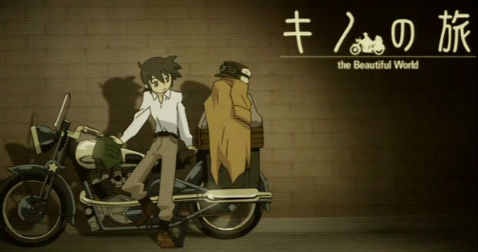
Kino’s Journey is a personal favorite of mine. Each episode is a parable, and I have a soft spot for any show that leaves you thinking about its messages long after you have finished viewing it. Plus, there is something about a never-ending search for someplace that makes you want to stick around, that resonates with lost souls living in a time when people have never been more connected, yet never felt so alone.
Links:
Staff Rankings: Lionrampant's Top 5 Anime of the Decade
5) Ah! My Goddess: The Movie (2000)
Airing in early 2000, this one barely slips in. The story itself is rather average, and won't make much sense to those new to the franchise, but beautiful animation of some of my favorite characters combined with a beautiful soundtrack makes this one of my favorite movies, and a fitting addition to the list. Hey, you didn't think I could let this list go by without at least one Fujishima property, did you?
4) Wolf's Rain (2003)
Slipping under a lot of people's radars, this science-fantasy show about wolves trying to find paradise ended up being way better than I had hoped. It isn't a happy tale, but stories about the end of the world rarely are. A stellar Yoko Kanno soundtrack doesn't hurt, either.
3) Pani Poni Dash (2005)
I realize this choice says bad things about me, but I can't help it. Of all the comedies I watched this decade, I laughed more at this show than any other. It makes no sense, but it is hilarious. A knowledge of anime and manga in-jokes is highly recommended to get the most from this show.
2) Ghost in the Shell: Stand Alone Complex (2002)
A tour de force performance from start to finish, this show spanned two seasons and a movie. Essentially a re-telling of the original story with more of a modern anti-terrorist slant, the animation and direction were spot on. An excellent English dub helped this show reach a wider audience than most.
1) Haibane Renmei (2002)
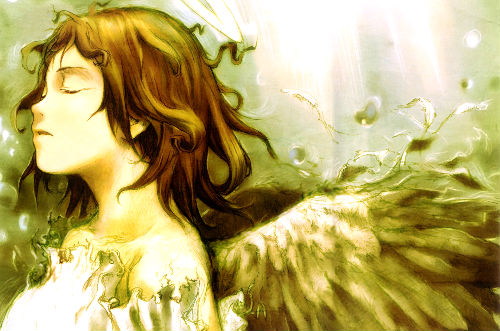
Describing this show as "spiritual" doesn't really do it justice, though it is accurate. The characters in this show have so many layers, and what you originally think the show is about isn't actually what it is about at the end. Beautiful background paintings blend with deep characters and solid acting and writing to deliver one of the best shows of the decade. I think about this show more than probably any other I have ever watched.
Links:
Staff Rankings: Mark's Top 5 Anime of the Decade
(Ed. Note: Mark heard about the Top 5s effort at the last minute, and was unable to provide rationales. Regardless, here is his list.)
5) Genshiken (2004, 2007)
4) Claymore (2007)
3) Macross Frontier (2008)
2) Lucky Star (2007)
1) Twelve Kingdoms (2002)
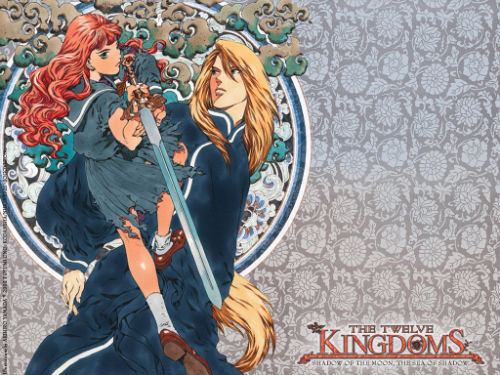
Staff Rankings: Tsukasa's Top 5 Anime of the Decade
5) Kanon (2006)
Big-eyed weepy sad girls in snow. Toei animation produced a 13-episode TV series based on Key/Visual Art's first ero-ge back in 2002, and KyoAni followed that with an all-around higher quality 24-episode adaptation in fall 2006. I enjoyed both thoroughly on their own merits for the compelling, emotional central story and engrossing snowbound atmosphere. Magical is the word that embodies this series for me, making it a personal pick of the decade.
4) Genshiken (2004)
Not since Otaku no Video has there been such a comprehensive look at, and parody of, otaku subculture. Where in Otaku no Video and Comic Party, we saw otaku shamelessly pursuing their hobbies and glorifying their antisocial pursuits, Genshiken represents the most honest depiction of otaku we have seen in anime to date: obsessive, perverted, socially inept, and beneath all that, as human as anybody else. Easily the smartest and funniest take on the otaku world to date.
3) Planetes (2003)
From TOKYOPOP's English language release of the first book of the manga, I was hooked on Planetes. Hard science fiction anime and manga are not exactly commonplace, and at first glance, you'd think it'd be difficult to make a series about orbital garbage collectors interesting, but as short as the manga is, it packs a tremendous amount of excellent character writing in a unique setting. The anime brings some out of place comic relief into the picture, but balances it out with stellar writing for new characters and an increased scope for the overall story, even discussing the politics of development in space and its impact on third and first world nations.
2) Banner of the Stars (2000)
Banner made its debut on Japanese TV around the time I first discovered Crest of the Stars back in high school and was impressed by the depth of its character writing and cultural exploration. Banner continued Crest's fantastically well written space opera saga of the Abh Empire into their conflict with the United Mankind, yielding an even more engrossing second season for Jinto and Lafiel's story. Up there with the late '90s' Infinite Ryvius as one of the best anime space operas in a long time, with some of the tensest battle scenes I've ever seen. Banner easily earns its position as my second favorite show of the decade, having aired all the way back at the beginning.
1) Haibane Renmei (2002)

Yoshitoshi ABe first made a splash back in the '90s with Serial Experiments LAIN, as confusing and convoluted as it was. He followed that with the much less noticed NieA_7 early in the decade — an eccentric comedy consisting of a lot of interesting ideas especially difficult to sell western otaku on. He followed that with 2002's Haibane Renmei, my personal pick for show of the decade, a Haruki Murakami-inspired story of young winged women hatched from cocoons into a strange society, seeking what it means to be who they are, and what it means to live. On every level, this show is Yoshitoshi ABe's masterpiece.
Links:
Staff Rankings: Mike's Top 5 Anime of the Decade
5) Yugo the Negotiator (2004)
Yugo is a series that I was skeptical about, at first; however, I had to give it a shot after some very positive words from a few friends. The show blew me away. Watching Yugo talk his way through the harsh conditions of Pakistan and Russia was simply exhilarating. The two arcs felt more like parts of a film than episodes in a series. And, the excitement and danger of a negotiator's life was conveyed beautifully as Yugo earned the trust of militants, and secured victories through his missions.
4) Ai Yori Aoshi (2002)
Ai Yori Aoshi is one of those shows that comes around every so often. It's a harem show, yes. But the relationship between Kaoru and Aoi is one that just felt, well... real. The experience declines somewhat once the gears shift from romance to a strange cross between drama and harem, but the main story is strong enough to pull Ai Yori Aoshi through all 36 episodes.
3) Black Lagoon (2006)
Black Lagoon was just too fun to avoid mentioning. It is an excellent action show that doesn't go too far with the fantasy, nor does it hit the now-normal high levels of emo. It is just Revy, Dutch, and to a lesser extent Rock and Benny kicking ass and earning their pay on the high seas. The action is fast and furious, the kill counts are high, and the adrenaline just keeps up through all 26 episodes. The characters are likable, and more down-to-earth in their quirks.
2) Haibane Renmei (2002)
I'll admit it — Haibene Renmei caught me by surprise. I really didn't expect to enjoy it as much as I did. On that note, I also didn't expect a show to make me think as much as Haibane Renmei, either. The amazing artwork, the lush visuals, and excellent music really come together to help bring the world to life. However, it is the top notch writing and characters that really makes this special. It is one of those shows that gave me a bit of an existential moment as I asked, "why?" when the end credits rolled. But, at the same time, I didn't want to see more — I knew the show had run its course, and run it well.
1) Ah! My Goddess TV Series (2005)
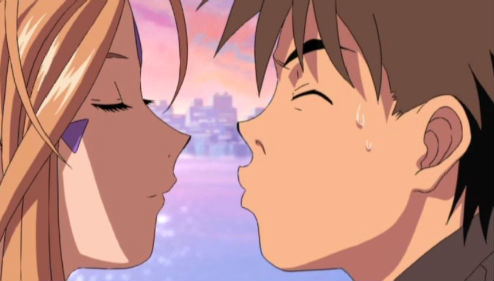
I'll admit that I have been wanting this for many, many years. I love Ah! My Goddess, and ate up all of the OVAs. The TV series ended up being everything I hoped for, and then some. The story is still as sweet as I remember, and the characters are just as lovable.
Links:
Staff Rankings: Matt's Top 5 Anime Movies of the Decade
This is me yelling, "I just can't do it!" I can't pick only five anime to hold up as the best in the decade, that is. So I've picked sixteen of them, presented over two lists. This first list is my picks for the best anime movies that premiered this decade. This was a very good decade for anime movies.
5) Paprika (2006)
Satoshi Kon is just awesome. His films blur the line between dream and reality, and doing so actually makes the message clearer. His style enjoys a natural symbiosis with Yasutaka Tsutsui's Paprika, a novel about a jealous scientist's theft and misuse of a psychotherapy device, one that allows the therapist to see (and affect) a patient's dreams. The situation grows more chaotic as the book progresses, to the point where nightmares seem to invade reality. Creepy, provocative, and intriguing, Kon's adaptation takes the viewer on a wild ride through the world of dreams.
4) The Place Promised in Our Early Days (2004)
I'm in the minority on this, but out of the three films Makoto Shinkai conceived and released, this one is my pick as his best. Set in an alternate reality where Hokkaido (Ezo) seceded from Japan, it's the story of two young men (Takuya and Hiroki) and a young woman (Sayuri) who are the closest of friends, until circumstances tear them apart. Sayuri is trapped in a dream she can't awaken from, but fears waking up, despite the loneliness. Takuya tries to move on with his life, while Hiroki obsesses over a promise that they had all made, to fly their homemade airplane to the gigantic tower rising over Ezo. The story weighs the crushing burden of sentiment against the sedated, robotic grind of adulthood, and hopes for a balance. It's wish fulfillment, but that's okay; not everything has to subscribe to the cynic's view.
3) The Girl Who Leapt Through Time (2006)
We can't go back in time, and we can't fix mistakes we've already made, so we obsess in literature about what would happen if we could. It might seem pointless, because we can't. Regardless, it's an interesting exercise, and enough cycles are built into the human condition that adding another infinity of them won't make much of a difference. The point is: we like these stories, and Yasutaka Tsutsui wrote one of them for us, which Mamoru Hosoda adapted into an animated movie.
It's the story of a girl named Makoto, who first has a bad day, then tries to fix it with time travel. We laugh and cry as she discovers that she can't cheat time after all, but we want her to be happy, because she makes us happy.
2) Spirited Away (2001)
Being that Spirited Away rocked our worlds 9 years ago, I don't need to count the ways in which this Hayao Miyazaki masterpiece is, um, masterful. The lovable Chihiro's adventures in the world of spirits marks a high point in Miyazaki's portfolio that can only be trumped, in my mind, by Porco Rosso. The film's message is simple: greed kills, and modesty heals. Still, I can hardly think of other animated movies that're such an absolute pleasure to watch, and it's gorgeous in all its hand-drawn glory.
1) Millennium Actress (2001)
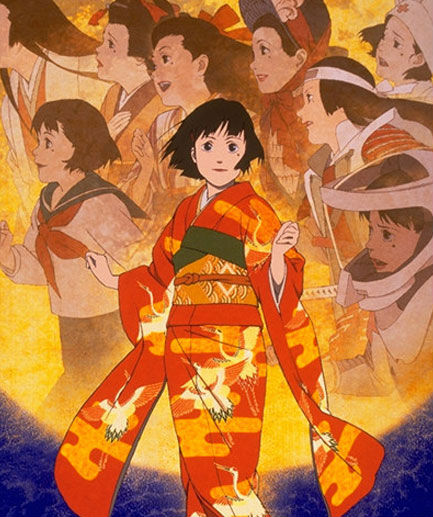
Satoshi Kon's portrayal of a beloved post-war actress's life, via an interview being done for a documentary, is compelling in a way that I've yet to find an explanation for. On the surface, Chiyoko's story is about a chase for a man, both at work and in her personal life. Kon's reality distortion kicks in with our documentary crew as they both record and participate in the events of Chiyoko's life and career, and through it all, the real Chiyoko emerges. She is cursed, never having the chance to catch up with her target, and yet she shines with the beauty of youth. Brilliance has a name, and it is Millennium Actress.
Links:
Staff Rankings: Matt's Top 5 Anime Series of the Decade
6)
All right, so because I'm the boss and I can, I'm going to cheat and make a number 6 out of all the series that I couldn't bear not to mention. Here they are:
Last Exile
I cried a little when making the decision to exclude this title from my top five. It's about as perfect a show as Gonzo will ever manage, telling the story of underdogs opposing tyranny, using both personal and wide-scale perspectives. The aerial setting is fascinating and the characters lovable.Magical Shopping Arcade Abe no Bashi
This show set the bar higher for parody anime, by running a fantastic character drama in parallel with the comedy. It's the story of a couple kids who experience a bend in time and space when a family tragedy occurs.Princess Tutu
Because what guy can't enjoy a cute little girl performing flawless ballet to save her fairy-tale beau's heart from the clutches of an evil bird lady? Besides, any anime soundtrack that uses Tchaikovsky is a winner in my book.School Rumble
This title was a strong candidate for the top 5, but its jokes rely so much on the viewer having some familiarity with Japanese culture that I hesitated. That said, this romantic comedy is one of the funniest shows I've had the pleasure of watching these ten years, right up there with His and Her Circumstances (when it's funny). Even before the first season is over, the characters feel like family.Space Pirate Captain Harlock: Endless Odyssey
This installment in the Harlock saga (not to be confused with Harlock Saga) is insanely addictive. It brings back Tadashi Daiba, a young man looking for his father's murderer, and rounds the old crew up for an epic confrontation with evil itself, to decide the fate of Earth.Wolf's Rain
Watch this show for the experience of watching a world fall apart and give way to primal instincts. Or watch it for the experience of a primal beast nurturing human characteristics at world's end to shine a light of hope. Both apply.
5) Planetes
Space debris is a real problem which affects us right now. The NASA Orbital Debris program tracks close to twenty thousand objects larger than 10 centimeters, and estimates that there are tens of millions of smaller objects circling Earth. Any one of these objects could potentially destroy a spacecraft, so in the near future, there are astronauts who collect this space garbage or send it downward to burn in the atmosphere. Planetes tells the personal stories of a few of these astronauts, but also gives the larger picture of how much politics and petty corporate infighting rules the human presence in space — both in the show's time period and ours. It's a sci-fi that I could really wrap my head around, and for that, it deserves a spot on my short list.
4) Mushi-Shi (2005)
Mother Earth, or Gaea, or Mother Nature — despite the name, it's a concept that people are familiar with all over the world. In the world of Mushi-Shi, it is the paradoxical mushi, who exist but cannot be said to be alive, who form the stream of life — nature's arteries. Because mushi exist outside the realm of observable nature, it takes a special type of person (a mushi-shi, or mushi master) to perceive and study them, and protagonist Ginko is such a person.
This show is very Japanese in style — uncorrupted, it seems, by Western influence, and for that, I'd love to see more like it. That's not to say it has no familiar elements. It's a traveler's tale, and each episode sees Ginko restore the natural balance (or try to) and move on. The show is poetic in its telling, and the subject matter is fascinating.
3) X TV (2001)
There are two shows about the apocalypse that are awesome all around. Wolf's Rain is one of them, and tells a story of a natural upheaval and the degradation of civilization that goes with it. But for this spot, I had to give the honor to X, which approaches the apocalypse as a mystical battle between the so-called Dragons of Earth and Dragons of Heaven. Based on the manga by CLAMP, X nails what I'll call the rhythm of world's end, for lack of a better wording. It's everywhere; in the soundtrack, dialogue, artwork, characterization, and story progression appears the hand of fate, guiding character and viewer alike to the inevitable.
That's not to say there's no hope. The raw appeal of X comes in the notion that the battle lines will be drawn no matter what, and the victor determines the fate of the world. Kamui, the protagonist, is given the choice of which side to fight for, and the rest is decided according to that choice. The fights are emotional and tragic, and the characters are impossible to forget.
2) Banner of the Stars (2000, 2001)
I realize it's a bit unfair to list this series, being that it's a direct sequel and continuation of Crest of the Stars, and draws some of its awesome from its predecessor, but I can't live in a world where this show doesn't receive its just recognition. Hiroyuki Morioka's simultaneously personal and broad sci-fi opera chronicles the genesis of a second iteration of humanity — test tube creations with superior intellect and having a lifespan of twice that of their human creators, who use their abilities to gain independence and build a vast empire, the likes of which the universe had never seen.
Crest of the Stars introduced us to human Jinto and Abh Princess Lafiel — a classic world's collide story where the multitude of differences in their lives make each intriguing to the other. Banner moves the story to the next phase: the two are already friends, and they have to work together aboard Lafiel's attack vessel to fight a war. On a personal level, the story unfolds as it did before, with no shortage of cultural differences between Abh and humans to explore. In fact, Banner steps it up by showing the diversity among the two humans working the bridge of the Basroil, as well. The space battles are adrenaline-packed, and the show does a terrific job of letting the viewer in on tactics and strategies employed at all levels of the battle. It's an incredible experience, and has one of the highest repeat-view counts of anything in my collection.
1) Haibane Renmei (2002)

I don't know where to begin, other than to say that Haibane Renmei affected me in a way that no other anime series or movie could. In a nutshell, it's the story of beautiful, angelic girls who feel terrible pain and work through it together, but the whole of the series is so much more. It's about taking responsibility for what you've done without letting the guilt eat you alive. It's about getting help when you can't heal yourself, and reaching out to those who need you, and knowing you're needed. Haibane Renmei doesn't judge, prod, or pressure its characters, though there is a sense that none of them have an unlimited time to figure things out. The intense emotions in the series are met with profound relief, in what amounts to a spiritual experience. This is the one anime that I can say with certainty made me feel like a different person afterward.

